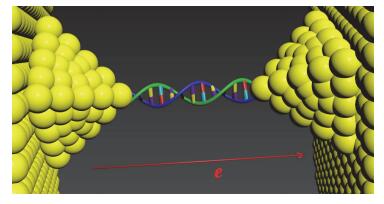摘要/Abstract

脱氧核糖核酸分子是一类重要的生物分子, 在生物医学领域之外, 该类分子还因为其所具有的独特的双螺旋结构以及长程输运能力, 在分子电子学领域也引起了研究者的极大兴趣. 本文综述了近年来基于纳米间隔电极对构筑分子结这一研究范式, 在构筑脱氧核糖核酸分子结以及研究后者的电输运性质等方面的研究进展. 依据研究者所采用的不同纳米间隔电极对构筑技术, 主要围绕裂结法和切割法两大类研究方法所展开. 前者主要包括扫描隧道显微镜裂结法、导电原子力显微镜法、机械可控裂结法, 后者则主要包括碳纳米管切割法、石墨烯切割法、硅纳米线切割法. 在梳理不同实验方法的发展脉络、比较不同实验方法的各自特点的基础上, 对一些具有代表性的关于脱氧核糖核酸分子结的研究工作进行了重点介绍, 探讨了脱氧核糖核酸分子结所具有的与常规小分子体系所不同的特殊电学性质, 同时对该领域的未来发展进行了展望.
关键词: 分子电子学, 分子结, 脱氧核糖核酸, 电输运
Molecular electronics is an interdisciplinary science that mainly studies the charge transport through molecules and its main goal is to fabricate molecular devices with electrical functionalities. In the state-of-art of molecular electronics, the research paradigm is to fabricate electrodes pair with nanometer-sized separation and construct the molecular junction through the assembly of target molecules with the electrodes pair. With this framework, the target molecule can be integrated to the macroscopic measurement circuit. DNA is one of the most significant biomolecules in natural sciences. It had drawn great attentions in biomedicine because of the carried genetic instructions. In molecular electronics, DNA also had attracted much interest due to the distinct structure and its capability of long-range charge transport. Nevertheless, in the early stage of molecular electronics, the probe molecules were limited to those with simple structures and short lengths. In recent years, molecular electronics had witnessed a rapid progress due to the developments in micro/nano-fabrication and the detection for weak current signal. Specifically, it includes the improvements in the success rate, efficiency, and stability of the fabricated molecular device. Benefiting from that, the probe molecules had been extended to a number of complex compounds like DNA. We give a brief introduction to the recent progress in the fabrication of DNA molecular junctions and the studies on the corresponding charge transport, most of which were made by using the research paradigm of fabricating electrodes pair with nanometer-sized separation. According to the fabrication methods that employed, these advances were introduced in two classes. One is that made by the as-called break junction methods, which include STM-break junction, conductive AFM and mechanically controllable break junction. The other is that made by the as-called cutting methods, which include cutting of carbon nanotube, graphene and silicon nanowire. We summarize the historical development of these methods and give a comparison between them. We also introduce some representative research on the charge transport through DNA molecular junction, and discuss the distinct features of DNA in electrical properties compared to the conventional small molecules. To conclude, we give a prospect on the future development of the studies on charge transport through DNA molecular junction.
Key words: molecular electronics, molecular junction, DNA, charge transport
PDF全文下载地址:
点我下载PDF
